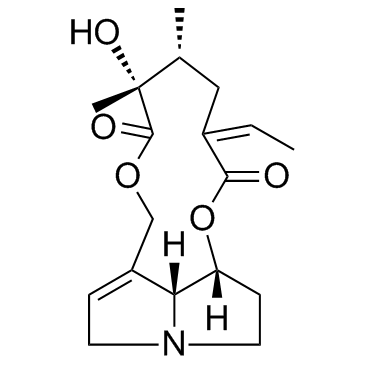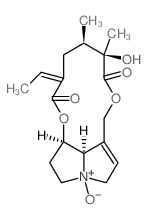Senecionine

Senecionine structure
|
Common Name | Senecionine | ||
|---|---|---|---|---|
| CAS Number | 130-01-8 | Molecular Weight | 335.395 | |
| Density | 1.3±0.1 g/cm3 | Boiling Point | 563.7±50.0 °C at 760 mmHg | |
| Molecular Formula | C18H25NO5 | Melting Point | 236ºC(lit.) | |
| MSDS | Chinese USA | Flash Point | 294.7±30.1 °C | |
| Symbol |

GHS06 |
Signal Word | Danger | |
Use of SenecionineSenecionine is a pyrrolizidine alkaloid isolated from Senecio vulgaris. Senecionine is toxic to animals and humans. |
| Name | senecionine |
|---|---|
| Synonym | More Synonyms |
| Description | Senecionine is a pyrrolizidine alkaloid isolated from Senecio vulgaris. Senecionine is toxic to animals and humans. |
|---|---|
| Related Catalog | |
| In Vitro | Pyrrolizidine alkaloids (PAs) are considered to be one of the most hepatotoxic groups of compounds of plant origin and are present in about 3% of the world's flowering plants. Most PAs represent a considerable health hazard to both livestock and humans through the consumption of plants and PA-contaminated products such as milk, honey, herbal teas, and medicines[1]. |
| In Vivo | Upon intravenous administration and oral administration of Senecionine and Adonifoline, significant differences in pharmacokinetics were observed, with the Senecionine and Adonifoline being absorbed fast with lower bioavailability and being quickly metabolized to PA N-oxides and hydroxylation products of PAs or their N-oxides[1]. Senecionine fails to stimulate epoxide hydrase, it diminishs the activity of glutathione-s-transferase, aminopyrine demethylase and AHH[2]. Twice-weekly injections of a third constituent, senecionine, beginning on Day 12 or later, results in premature deliveries in three of seven rats, and the pups from all litters are stillborn or die shortly after birth[3]. |
| Animal Admin | Rats[1] Swiss albino rats weighing 155-175 g are incubated for 3 consecutive days with seneciphylline and senecionine at a daily dose of 40 or 80 mg/kg body wt. Control animals received normal saline only. The animals are killed 24 h after the last dose. The livers are removed, weighed and then homogenized in 1.15% KCI, 0.02 HEPES (pH 7.4)[1]. |
| References |
| Density | 1.3±0.1 g/cm3 |
|---|---|
| Boiling Point | 563.7±50.0 °C at 760 mmHg |
| Melting Point | 236ºC(lit.) |
| Molecular Formula | C18H25NO5 |
| Molecular Weight | 335.395 |
| Flash Point | 294.7±30.1 °C |
| Exact Mass | 335.173279 |
| PSA | 76.07000 |
| LogP | 0.88 |
| Vapour Pressure | 0.0±3.5 mmHg at 25°C |
| Index of Refraction | 1.570 |
CHEMICAL IDENTIFICATION
HEALTH HAZARD DATAACUTE TOXICITY DATA
MUTATION DATA
|
| Precursor 0 | |
|---|---|
| DownStream 1 | |
|
UPLC-MS/MS method for determination of selected pyrrolizidine alkaloids in feed.
Food Chem. 170 , 265-70, (2014) Alkaloids known as secondary metabolites are grouped by typical structural characteristics into large families such as pyrrolizidine alkaloids (PAs) comprising more than 350 individual heterocyclic co... |
|
|
Modeling K(m) values using electrotopological state: substrates for cytochrome P450 3A4-mediated metabolism.
Bioorg. Med. Chem. Lett. 15 , 4076-84, (2005) In order to determine K(m) values of substrates for CYP3A4-mediated metabolism, an in silico model has been developed in the present work. Using electrotopological state (E-state) indices, together wi... |
|
|
A competitive enzyme immunoassay for the pyrrolizidine alkaloids of the senecionine type.
Planta Med. 62(3) , 267-71, (1996) We developed an immunoassay with antibodies against retrorsine to detect the closely related senecionine, the main alkaloid in various Asteraceae. Sensitivity is about 23 pg (68 fmol) for senecionine.... |
| (3Z,5R,6R,14aR,14bR)-3-éthylidène-6-hydroxy-5,6-diméthyl-3,4,5,6,9,11,13,14,14a,14b-décahydro[1,6]dioxacyclododécino[2,3,4-gh]pyrrolizine-2,7-dione |
| aureine |
| Senecionine |
| MFCD00221720 |
| (3Z,5R,6R,14aR,14bR)-3-Ethyliden-6-hydroxy-5,6-dimethyl-3,4,5,6,9,11,13,14,14a,14b-decahydro[1,6]dioxacyclododecino[2,3,4-gh]pyrrolizin-2,7-dion |
| [1,6]Dioxacyclododecino[2,3,4-gh]pyrrolizine-2,7-dione, 3-ethylidene-3,4,5,6,9,11,13,14,14a,14b-decahydro-6-hydroxy-5,6-dimethyl-, (3Z,5R,6R,14aR,14bR)- |
| (3Z,5R,6R,14aR,14bR)-3-Ethylidene-6-hydroxy-5,6-dimethyl-3,4,5,6,9,11,13,14,14a,14b-decahydro[1,6]dioxacyclododecino[2,3,4-gh]pyrrolizine-2,7-dione |
| (15Z)-12-Hydroxysenecionan-11,16-dione |
| Integerrimine |
 CAS#:13268-67-2
CAS#:13268-67-2
